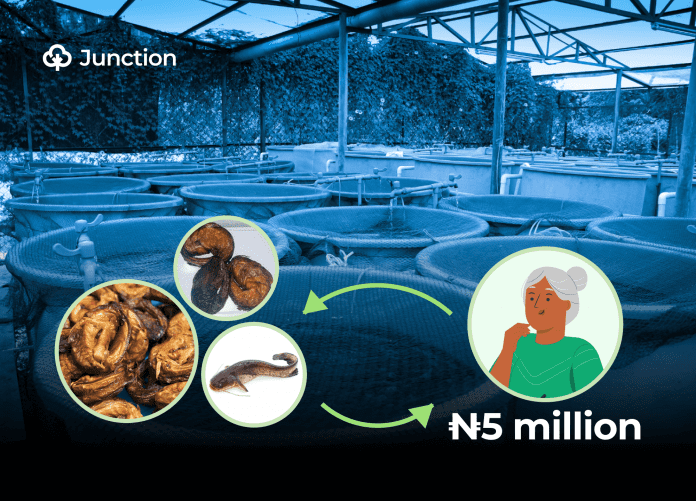Retirement in Nigeria presents relief from years of hard work and career climbing. While the official retirement age is 60 years, the average life expectancy hovers around 55 years, according to the National Bureau of Statistics. This discrepancy means many retirees may not enjoy the fruits of their labour for long, and those who do often face significant financial and psychological challenges. Insufficient pension funds and the high cost of living exacerbate these difficulties.
According to the Nigerian Pension Commission, over 60% of retirees face financial difficulties post-retirement, underscoring the need for retirement plans. While some retirees opt for leisure, others seek purpose and engagement. I will explore why catfish farming offers a promising opportunity for post-retirement income for retirees.
Why catfish farming?
Agriculture remains the cornerstone of Nigeria’s economy, contributing approximately 24% to GDP. Within this sector, catfish farming stands out for its profitability and the rising demand for fish. Nigeria, identified by the Food and Agriculture Organization (FAO) as sub-Saharan Africa’s largest aquaculture producer, faces a substantial deficit in meeting its annual fish demand of 3.6 million metric tonnes, against local production of 1.1 million metric tonnes (MT). This gap presents a lucrative opportunity for aspiring fish farmers.
- High Demand: Catfish is a popular protein source across Nigeria, ensuring consistent market demand.
- Short Production Cycle: Catfish mature in 4-5 months, allowing for relatively quick returns on investment and multiple cycles per year.
- Scalability: The business can start small and expand gradually with increasing skills and resources.
From Teaching to Catfish Farming
To illustrate the challenges and benefits of transitioning into catfish farming, I spoke with Mrs. Ngozi, a retired teacher who has successfully operated a catfish farm for over five years. Beginning her teaching career in 1996 after earning her Nigeria Certificate in Education (NCE), Mrs. Ngozi and her husband initially explored other agricultural ventures but settled on catfish farming due to its compatibility with available space and market demand.
“I was talking with a colleague some years back. He asked if I was planning for life after teaching. I hadn’t at the time. It was a wake-up call for me,” she recalls.
“We tried planting Ugwu (Pumpkin leaves) at first but when it rained, the swamp flooded the compound and ruined the farm. We did not harvest anything because of excessive rainfall. We also considered starting a poultry farm but because of the surrounding bushes, we were afraid of snakes coming into the compound and killing the chickens,” she says. That was when they decided on catfish farming. But how did she and her husband start the farm in 2018?

Starting a catfish venture
“Initially, we underestimated the required capital,” admits Mrs. Ngozi. Their 2018 startup costs exceeded the budgeted ₦800,000 for land preparation, pond construction, and purchasing fingerlings and feed. Opting for cost-effective plastic ponds at ₦60,000 each helped manage expenses a little.
Overcoming old challenges in catfish farming
In addition to financial hurdles, inadequate electricity supply remains a significant challenge for Nigerian farmers, impacting operational costs and sustainability. Mrs. Ngozi highlighted the necessity of frequent pond cleaning to prevent fish infections, a critical aspect of maintaining productivity amidst erratic power supply and rising fuel costs.
Many farmers like Mrs. Ngozi struggled to maintain their farms due to the volatile inflation of fuel prices last year. An occurrence that is related to the fluctuation of the dollar in the exchange market.
“A bulk of the profit goes into buying fuel,” she lamented. “With frequent price hikes, it becomes harder for farmers to bear the cost. We require lots of water to avoid polluting the environment, so my husband and I are constantly changing the ponds’ water to prevent infection.”
“We had noticed that by week four or five, if we did not keep washing the ponds, the fishes start getting infected,” she added, explaining why they required so much water for their farming. “Following the advice of a more experienced catfish farmer, we wash the pond once a week during the fishes’ first three weeks, then once every two weeks, and once a month after two months. This routine worked well and helped reduce infections caused by feed and excreta left too long in the ponds.”

When asked how she manages the price fluctuations in feed, she responded, “you buy what your money can afford. Nobody wants to sell on credit anymore because of the economic situation of the country.”
Late in 2023, feed sellers began hoarding their goods due to rising prices, she said. “In one week, feed prices could rise three to four times. I had to increase my budget for feed by 300% at one point. However, now (June 2024), the prices are a bit stabilised as the exchange rate is no longer changing as frequently.” But feed pricing was not the only thing that has become stabilised, her work-life balance too.
Daily routine and market strategy
Catfish farming demands dedication and a meticulous daily routine to ensure healthy growth and optimal market readiness. Mrs. Ngozi begins her day with a thorough inspection of the fish, emphasising the importance of observing their behaviour and skin colour in the early morning to detect any signs of infection or stress promptly. She feeds them twice a day, with a heavier feeding in the morning and a lighter one in the evening.
“This work isn’t stressful due to the scale at which I manage them. It allows me to engage in other activities like church programs.”
Catfish typically reach maturity for sale in about three months, although additional time is needed to achieve table size. To prevent fish from bullying each other, Mrs. Ngozi sorts and place them by size every two weeks, ensuring fair access to food. She highlights that proper feeding significantly influences the fish’s final weight and market value. Buyers, especially those purchasing fish for drying, prefer them around 13 to 14 weeks of growth.

When it’s time to sell, networking with fellow catfish farmers helps Mrs. Ngozi stay informed about current market prices and demand trends. This communication ensures she can decide on the best time to sell her stock, maximising profitability and becoming a successful catfish farmer over the years.
Achieving success in catfish farming
Despite facing initial setbacks, Mrs. Ngozi’s determination propelled her forward. She and her husband sought advice from experienced farmers and adjusted their strategy. They began focusing on the quality of fingerlings and proper feeding practices, leading to healthier and larger fish. By the third year, they had established a reliable buyer network and started selling directly to local markets and restaurants.
Their efforts paid off. By 2021, Mrs. Ngozi’s farm was producing approximately 10,000 kilograms of catfish annually, generating a revenue of about ₦5 million per cycle. With an average profit margin of 20%, they steadily increased their profitability. This success allowed them to reinvest in their farm, constructing two extra ponds to accommodate increasing demand.
“More than buyers, I need capital,” she explains, highlighting how demand often exceeds her current supply capabilities. Presently, she sells fish every four months but envisions doubling her turnover to every two months with adequate funding.
Her advice to aspiring catfish farmers, especially the youth, is straightforward: “If you lack sufficient capital, reconsider starting this business.” The capital-intensive nature of catfish farming requires careful planning and a robust financial strategy to succeed. “But be rest assured, you will make a huge profit,” she adds.
Catfish farming presents a viable post-retirement business opportunity in Nigeria, blending economic viability with agricultural innovation. Do you have what it takes to venture into catfish farming? You don’t have to wait till retirement before starting catfish farming as a side hustle. For those considering catfish farming, understanding the challenges and planning accordingly can make a significant difference in achieving success.




